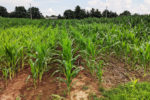Advertise Follow Us
No-Till Farmer News
[Podcast] Plant Once, Harvest for Years with Perennial Kernza
For this No-Till Farmer podcast, sponsored by Yetter Farm Equipment, Contributing Editor Dan Crummett speaks with plant biologist Lee DeHaan of The Land Institute where the breeding of Kernza and other perennial crops has been underway since 2003. Listen in as Dan and Lee discuss the characteristics of Kernza, how to grow it, the potential of the developing markets and more.
Read More








